Nutritionally speaking, is oaxaca light cheese different from a conventional cheese?
Abstract
Oaxaca cheese is a soft and plastic curd cheese, crumbly, with a firm body, creamy white color, soft flavor and slightly acidic. The main characteristic is its elastic consistency, since the curd can be molded into a round and braided shape. Due to the high fat content the dairy industry has innovated with the production of Oaxaca Light cheeses as an alternative in low calorie products. On the other hand, the high content of sodium that characterizes these products allows to maintain an adequate texture, besides contributing in its conservation. The purpose of this work was to establish a nutritional comparison based on the information presented in the labeling of Oaxaca and Oaxaca Light cheeses that are sold in the city of Pachuca Hidalgo. 11 brands of Oaxaca cheese and 3 brands of Oaxaca Light cheese were evaluated, gathering the nutritional information and additives to make a comparison on their nutritional composition. Both in the conventional Oaxaca and Light cheeses covered the protein content (>20%), however, the fat content was adequate only in the conventional cheeses (it should not be less than 18%) according to the Regulation of Sanitary Control of Products and Services, which regulates these products, however, those products that presented a low fat content were used gums as an additive. The Light cheeses, compared to the conventional cheeses, presented a low lipid content, and therefore caloric, reason why they can be considered as a beneficial option within the feeding.
Downloads
References
NOM-243-SSA1-2010. Productos y servicios. Leche, fórmula láctea, producto lácteo combinado y derivados lácteos. Disposiciones y especificaciones sanitarias. Métodos de prueba. En: http://dof.gob.mx/normasOficiales/4156/salud2a/salud2a.htm
Ramírez, S. & Vélez, J. Queso Oaxaca: panorama del proceso de elaboración, características fisicoquímicas y estudios recientes de un queso típico mexicano. Temas Select Ing Alim. 2012; 6(1): 1-12.
Reglamento de Control Sanitario de Productos y Servicios. En: http://www.salud.gob.mx/unidades/cdi/nom/compi/rlgsmcsaeps.html
Mayta, H. J., Trujillo, A. J. & Juan, B. Tecnología de quesos en grasa. Rev, Investig. Vet. 2019: 30(4): 1382-1394.
Bello, J.M., Lizeldi, B., González, E., Manzo, A., Nochebuena, X., Quiñones, E.I. & Vázquez, C. Productos lácteos: la ruta de la metamorfosis. Revista Digital Universitaria. 2004: 5(7): 1-14.
NOM-051-SCFI/SSA1-2010. Especificaciones generales de etiquetado para alimentos y bebidas no alcohólicas pre-envasados. Información comercial sanitaria. En: http://www.dof.gob.mx/normasOficiales/4010/seeco11_C/seeco11_C.htm
CODEX-STAN 192-1995. Norma General para los Aditivos Alimentarios. En: http://www.fao.org/gsfaonline/docs/CXS_192s.pdf
Guzmán, V. Procesamiento de quesos. REDAR. 2012; 7(1): 31-34.
Acuerdo por el que se determinan los Aditivos y Coadyuvantes en alimentos, su uso y disposiciones sanitarias. En: https://www.dof.gob.mx/nota_detalle_popup.php?codigo=5259470#:~:text=Para%20los%20aditivos%20que%20se,el%20Ap%C3%A9ndice%20del%20Reglamento%20de
Castañeda, A., González, L.A., Granados, M.A. & Chávez, U.J. Goma Guar: Un aliado en la Industria Alimentaria. Pädi. Boletín Científico de Ciencias Básicas e Ingenierías del ICBI. 2019; 7(14): 107-111.
Sánchez, J. La química del color en los alimentos. Química Viva. 2013; 12(3): 234-246.










